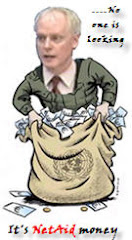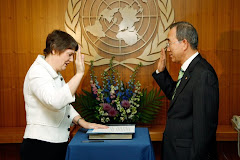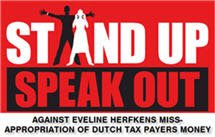
By George Russell
Call it the United Nations' version of spring training: the season of budgetary bracket creep has begun.
By the time it’s over, Secretary-General Ban Ki-Moon should have easily improved on his longstanding record as the biggest-spending U.N. secretary-general in history, by a respectable margin.
Nothing as obvious as that, of course, will be apparent this week, as the General Assembly considers a 19-page resolution entitled “Questions relating to the proposed program budget for the biennium 2010-2011.”
The resolution, an important step in the U.N.’s budgetary approval process, is larded with complaints about the lack of clarity in the current budget process, special pleading for various U.N. activities (notably, Palestinian relief efforts), and labyrinthine references to other U.N. reports.
And, tucked away in a one-page annex at the back, there is also a 220-person increase in the proposed “core” staffing of the bloated U.N. Secretariat that Ban originally announced last fall, as a model of frugality in tough economic times. It brings the “core” Secretariat staff from 10,061 to 10,281.
Click here for a table breaking down the staffing
The cost of the staffing increase is not included in the resolution. Asked by Fox News to provide such a cost figure, Ban’s office had not replied by the time this story was published.
The U.S. pays 22 percent of the “core” U.N. Secretariat budget. U.N. salaries, along with allowances for education and housing, among other things, are tax free.
The spring staffing hike has been a regular feature of U.N. budgeting since Ban took office in January, 2007, and indeed long before. So has the previous fall biennial budget proposal that promises the U.N. will be tough on costs, and tough on staffing increases.
To be fair to Ban, some of the staffing hikes are forced on the Secretariat by the General Assembly itself, which has its own pork barrel agenda. Both the revisions and the budget proposals, however, are part of an elaborate budgetary waltz, in which the U.N. low-balls original spending estimates, presents misleading comparisons of spending figures, updates those low figures at regular intervals, and — most importantly — excludes the vast majority of its spending from the “core” estimate that is the basis of so-called U.N. “dues.”
The rest of the money continues to come from the same relatively small number of Western nations, plus Japan, but they do not count it as a mandatory outlay of fixed percentages.
Last September, when Ban presented a frugal “core” budget of a little over $5 billion for 2010-2011 (U.N. budgeting is done on a two-year basis), the same document revealed that U.N. Secretariat spending, including “extrabudgetary” items, was planned at more like $13.9 billion.
Even that swollen number did not include rapidly spiraling U.N. outlays for peacekeeping, which were proposed to reach $7.8 billion just for the 12 months ending June 30, 2010. Since then, increased peacekeeping forces in Haiti and Somalia are likely to push that tally well past $8 billion.
The U.S. pays 26 percent of peacekeeping costs.
The conservative Heritage Foundation estimates that the U.N. “core” budget has been growing at an average rate of 17 percent annually since 2002. Ban, as the inheritor of that trend, is spending the most money of all his predecessors.
The history of Ban’s staffing hikes, however, indicates it may be even more difficult to rein in those costs in the future. One reason is that Ban is significantly increasing the number of high-cost U.N. bureaucrats in the mix.
In hiking the number of U.N. staff from 10,061 to 10,281, for example, Ban has raised the number of so-called Professional-level staffers as well as top-ranking under-secretaries general, assistant secretaries-general, and directors to 4,543. That’s up just 14 from his fall proposals — but it’s 206 more than in his last similar staffing revision, in 2008, and a whopping 408 more higher-level bureaucrats than the last budget proposed by his predecessor, Kofi Annan.
Salaries for professional-level employees and upwards at the U.N. vary widely. The lowest P-level staffer makes $47,968 annually, as of January 1, 2010, while the highest P-level staffer can earn $141,810. Director-level staffers and above earn from $137,021 to $201,351.
But for staffers in New York City, there is an additional mammoth adjustment for cost of living: 62 percent of base salary. That raises the overall range to between $77,708 and $326,188.
In general, roughly 60 percent of Ban’s “core” staffing increases since his 2008 budget revision have been in higher-paid staff. That ratio rises to about two-thirds when compared to Kofi Annan’s last budget.
If anything, the trend is more pronounced in the huge iceberg of the Secretariat’s none-“core” spending, which is misleadingly called “extrabudgetary” even though it has consistently employed about 12, 000 staff annually in the past four years.
According to Ban’s last proposed budget, roughly two-thirds of the “extrabudgetary” staff increase between biennia was higher-paid professional-levels and above.
Click here for the "extrabudgetary" comparison.
No increase in “extrabudgetary” staff was included in the resolution currently being debated by the General Assembly. Questions about such increases in “extrabudgetary” staffing had not been answered by Ban’s office before this article was published.
George Russell is executive editor of Fox News.
















































No comments:
Post a Comment